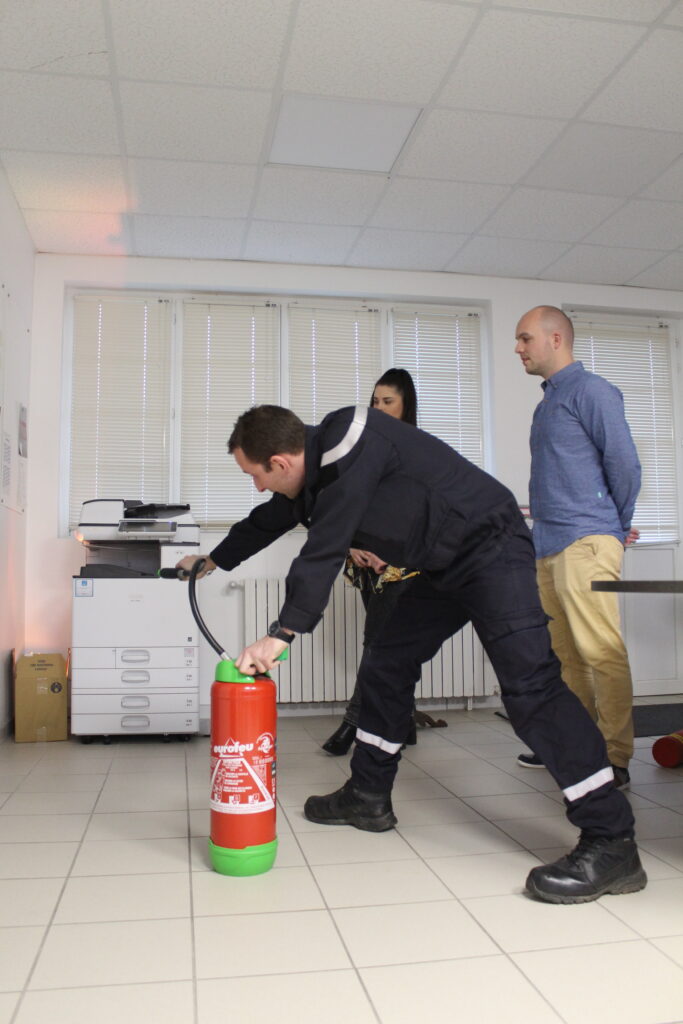Who can provide PPE training?
PPE training, for Equipier de Première Intervention, is essential for mastering fire-fighting techniques. The organizations authorized to provide this training are generally certified by INRS, and may vary from one establishment to another. They can be addressed to all employees, with no particular prerequisites. Although specialized, this training is accessible and may be mandatory for some companies.
Qualification criteria for PPE training
A number of criteria are required for PPE training. The trainer must have solid experience in fire safety, ideally validated by a diploma such as SSIAP (Service de Sécurité Incendie et d'Assistance à Personnes) or professional experience as a firefighter.
A thorough knowledge of current regulations, in particular article R4227-39 of the French Labor Code, is essential. Trainers must also be familiar with evacuation procedures and fire propagation methods.
The ability to carry out practical exercises is crucial to effective training. The trainer must be able to simulate emergency situations and supervise the use of extinguishing equipment.
Finally, certification by a recognized organization such as INRS is often required to attest to the quality and conformity of the training provided.
PPE training and fire extinguisher obligation in the workplace
The obligation to have a fire extinguisher in the workplace is governed by article R4227-28 of the French Labor Code. This stipulates that the employer must put in place the necessary measures to ensure that any outbreak of fire can be fought quickly and effectively.
Companies must have a sufficient number of fire extinguishers adapted to the specific risks of their activity. Fire extinguisher types vary according to the materials present in the company: water extinguishers for Class A fires, CO2 extinguishers for electrical fires, etc.
PPE training often includes practical demonstrations and fire extinguisher handling exercises. These sessions enable employees to familiarize themselves with the equipment and acquire the right reflexes in the event of a fire.
A concrete example: in a woodworking shop, employees need to know how to use a water-spray extinguisher to quickly bring a wood or paper fire under control.
The importance of retraining in PPE training
The PPE retraining process
To ensure effective PPE retraining, a number of steps need to be taken. The first is to organize practical training sessions, including live-fire exercises.
These sessions enable team members to brush up on firefighting techniques and become familiar with extinguishing tools. Theoretical input is also essential. They update knowledge of the latest safety standards and evacuation techniques.
INRS-certified organizations often offer refresher courses. These sessions are designed to be intensive and interactive, maximizing participant involvement. Here are some of the key points covered during these training sessions:
- Handling fire extinguishers
- Evacuation procedures
- Up-to-date safety instructions
Here's a concrete example: in the event of a fire, knowing how to cut off power and effectively alert emergency services can save lives.
Recommended interval for PPE retraining
Refresher PPE training must be carried out periodically to guarantee the effectiveness of team members. The current recommendation is to retrain every 12 months. This is not only to maintain acquired skills, but also to adapt to changes in safety standards.
In practice, retraining includes theoretical modules and practical exercises. Sessions generally last between 3 and 4 hours, and are 80% hands-on. Participants review evacuation procedures and fire extinguisher handling.
To illustrate the importance of this recycling, let's take the example of an industrial company. Regular drills enable employees to react quickly and effectively in the event of a fire, minimizing the risk to themselves and the company.
The impact of recycling on fire-fighting efficiency
PPE retraining improves fire response in several ways. Firstly, it keeps team members' skills up to date, particularly with regard to evacuation techniques and procedures.
This refresher course also encourages the acquisition of quick and appropriate reflexes in the event of an outbreak of fire. The practical exercises included in these training courses enable participants to familiarize themselves with equipment such as fire extinguishers and hose reels.
What's more, these refresher courses enable you to review safety instructions and adapt to new regulatory standards. For example, knowing how to cut off power and alert emergency services effectively can considerably reduce risks and damage.
Last but not least, retraining strengthens team cohesion and coordination, crucial elements for a successful intervention.
The consequences of not professionally recycling PPE
Failure to professionally recycle PPE can have serious consequences for workplace safety. Firstly, team members' skills can deteriorate, making their response to a fire less effective. This loss of know-how can compromise the ability to use fire-fighting equipment correctly.
Employee health risks are also on the increase. A lack of up-to-date training can lead to clumsy or dangerous interventions. For example, not knowing how to switch off power at the right moment can make the situation worse.
The legal consequences are not to be overlooked either. The employer may be held liable in the event of an incident, due to a breach of the safety obligation. Penalties may include fines or even imprisonment.
In short, regular retraining is crucial to guaranteeing safe and effective intervention, while protecting the company from legal repercussions.
The company's responsibility in PPE training
It is the company's responsibility to provide PPE training that complies with legal requirements. This includes prevention, information and training for all personnel.
The missions of this training course are varied and include :
- Handling fire extinguishers
- Knowledge of fire safety instructions
- Evacuating those present
Employees must be trained to react effectively in the event of fire. This preparation helps limit risks and protect employees' health.
The site manager must also ensure that PPE is properly used and maintained. Periodic checks must be organized to ensure the validity of training and the good condition of equipment.
Failure to meet these obligations can result in employer liability, with financial and legal penalties.
Integrating OHS training into the EPI program
Integrating OHS training into the PPE program offers several advantages. It enables employees to be trained to intervene effectively in emergency situations, while ensuring optimum coordination with first response procedures.
To provide this training, the organization must be certified by INRS or equivalent, thus guaranteeing quality and compliance with current standards. SST instructors must also be certified, to ensure quality teaching.
SST training courses include practical and theoretical modules, covering first aid and occupational risk prevention. A concrete example: a trained employee can quickly take charge of an injured colleague, while alerting outside help and securing the intervention area.
This synergy between OHS and PPE strengthens overall safety within the company, minimizing the risks and impact of accidents.
The importance of fire training as part of PPE
The basics of firefighting to be mastered in PPE
The basics of firefighting for First Response Teams (FRTs) include several essential aspects. First and foremost, PPEs need to be able to recognize different types of fire quickly. This enables them to use the appropriate extinguishing media, such as water, powder or CO2 extinguishers.
Next, it's crucial to know the procedures for sounding the alarm and alerting emergency services. Once the alarm has been sounded, PPE must be able to cut off energy to prevent the fire spreading.
They must also master evacuation techniques, including the management of safe waiting areas for people with disabilities. Here are a few key points to remember:
- Use of different types of extinguishers
- Knowledge of alarm and warning procedures
- Power cuts (gas, electricity)
- Management of secure waiting areas
These skills are fundamental to ensuring a rapid and effective response in the event of a fire.
Using fire extinguishers during a firefight
When responding to a fire, it's crucial to know how to use extinguishers correctly. Each type of extinguisher is designed to extinguish specific classes of fire. For example, water extinguishers are effective against Class A fires (wood, paper), while CO2 extinguishers are suitable for Class B (flammable liquids) and electrical fires.
To use an extinguisher, first remove the safety pin. Then direct the jet towards the base of the flames, maintaining a safe distance. Press the handle to release the extinguishing agent. Move sideways to cover the entire burning surface.
It's also important to remain vigilant at the source of the fire. If the situation gets out of control, evacuate immediately and alert emergency services. A quick, well-executed response can limit the damage and save lives.
Fire risk management in the workplace
Fire risk management in a company involves a number of preventive and corrective measures. Firstly, it is crucial to install an effective fire alarm system that complies with current standards. The characteristics of the sound signal must be clear and recognizable by all employees to avoid confusion in the event of an emergency.
Secondly, every company must have clearly defined and accessible assembly points. These points are used to check that all personnel have evacuated the premises. Employees must be trained in the use of fire extinguishers and other fire-fighting equipment.
To enhance safety, regular evacuation drills are essential. They test team responsiveness and coordination, and identify any weaknesses in evacuation procedures.
Recommended frequency for evacuation drills
Evacuation drills should be carried out at least every six months to ensure optimum preparedness in the event of fire. This frequency enables employees to familiarize themselves with evacuation procedures on a regular basis, and to reinforce their safety skills.
To increase the effectiveness of these exercises, it is essential to vary the scenarios. For example, organize evacuations simulating different types of fire or obstacles on exit routes.
In addition, including specific roles such as guide-files and greenhouse-files improves coordination. These roles ensure that everyone evacuates quickly and safely, directing people to the exits and checking that no one remains inside.
Finally, recording the results of exercises in a register helps identify areas for improvement and ensures compliance with regulatory requirements.



